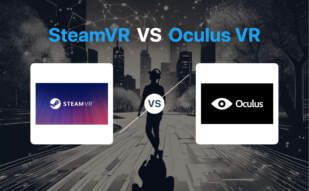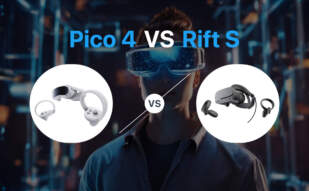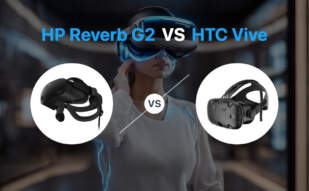Choose SteamVR for a comprehensive VR experience with customizable settings, in-app microtransactions, and wide headset compatibility including its own Vive. For a VR line that has consistently offered affordable, quality experiences with superior Field of View and resolution, Oculus Rift is the better pick.

Key Differences Between SteamVR and Oculus Rift
- Development: SteamVR is developed by Valve as a part of the Steam client, whereas Oculus Rift is developed and manufactured by Oculus VR.
- Headset compatibility: SteamVR supports various headsets including its own like Vive and others like Rift; Oculus Rift primarily works with Oculus headsets.
- Microtransactions: SteamVR supports in-app purchases; this feature isn’t prominent in Oculus Rift.
- Technology: Oculus Rift is noted for its large stereoscopic field-of-view and reduced screen door effect; SteamVR stands out with its 360-degree full room VR experience.
- Product Lifecycle: SteamVR continues to innovate with products like CyberShoes; Oculus Rift line was discontinued in 2021.
| Comparison | SteamVR | Oculus Rift |
|---|---|---|
| Initial Release | April 2016 | March 2013 |
| Most recent version | Mid-2022 | Rift S – March 2019 |
| Main Features | Room setup, device management, in-app purchasing, overlay applications | Geometric pre-distortion, large stereoscopic field-of-view, absolute head orientation tracking |
| Noteworthy Devices & Accessories | Valve Index, HTC VIVE, Base Stations, Steam VR Controllers, CyberShoes | Oculus Rift DK1, Rift CV1, Rift S |
| Operating System Required | Windows 7 SP1, Windows 8.1 or later, Windows 10 | Windows |
| Hardware Requirements | Intel Core i5-4590/AMD FX 8350 processor or better, NVIDIA GeForce GTX 970, AMD Radeon R9 290 equivalent graphics | None Specified |
| Positional Tracking Support | Yes – with base stations and input devices | Yes – with absolute head orientation tracking |
| Dedicated Software Development Period Started | 1830s | 2011 |
| Respected Partner | HTC – For HTC VIVE | Facebook – Acquisition in 2014 |
What Is SteamVR and Who’s It For?
SteamVR is a runtime within the Steam client that powers immersive virtual reality experiences. It’s automatically installed upon VR headset connection and offers in-app purchasing using the microtransactions API. Developed by Valve, SteamVR caters to both individuals seeking an enriched gaming experience and corporate users leveraging the technology to design 3D environments.

Pros of SteamVR
- Provides a comprehensive 360-degree full room VR experience
- Supports its own HMDs, such as Vive, and others like Rift
- Accessories like base stations and input devices enhance positional tracking
Cons of SteamVR
- Reported compatibility issues with Meta Quest 3 when using air link
- Relatively high system requirements
- Requires a PC setup
What Is Oculus Rift and Who’s It For?
Oculus Rift, a product line of VR headsets developed and manufactured by Oculus VR, paves the way for virtual reality’s renaissance. Founded by Palmer Luckey, Oculus Rift aims to offer realistic VR experiences at an accessible price point for gaming enthusiasts and technology aspirants alike.

Pros of Oculus Rift
- Offers superior quality and reduced cost due to novel technologies
- Provides wide FOV and improved clarity
- Retains compatibility with Oculus Rift S software library
Cons of Oculus Rift
- Discontinued production of Rift S in 2021
- Requires a high-performance PC for optimal usage
- Some users report discomfort during extended use
SteamVR or Oculus – Make the Right Choice
When it comes to top-notch VR experiences, the battle boils down to SteamVR versus Oculus. So, which one emerges as the undeniable victor? Let’s dissect this for distinct user groups.
VR Enthusiasts and Multi-HMD Users
SteamVR, without contest, proves superior. It offers compatibility with multiple HMDs, including its own, like Vive, and others, like Rift. Added to this, its SteamVR Home sets the gold standard as the launch pad for a gamut of VR experiences. If you value freedom in VR choice, SteamVR is your go-to.

VR Developers and Creators
If you’re all about creating immersive VR experiences, Oculus Rift’s innovative technology may just sway you. It revolutionized the VR space by offering a realistic experience at an affordable price, coupled with the impressive software library that remains compatible with the Oculus Quest. Oculus Rift’s emphasis on innovation and affordability makes it a developers’ darling.

Gamers and In-home Users
Gamers are bound to appreciate SteamVR’s commitment to enhanced gaming experiences. Room set-up for play area definition, augmenting devices, and SteamVR Collectibles all enrich the interactive scape. Add to that CyberShoes designed for Quest, and Cyberchair – both aimed at elevating in-home gaming experiences. For gamers, SteamVR is king.

In the clash of SteamVR vs Oculus, the decision is fuelled by personal preference and requirements. While SteamVR dominates in versatility and gaming experiences, Oculus steals the show with its innovation and developer-friendly ecosystem.
Logan Bellbrook
Content writer @ Aircada with a knack for nature & AR/VR/XR. Blogging the intersection of tech & terrain.





